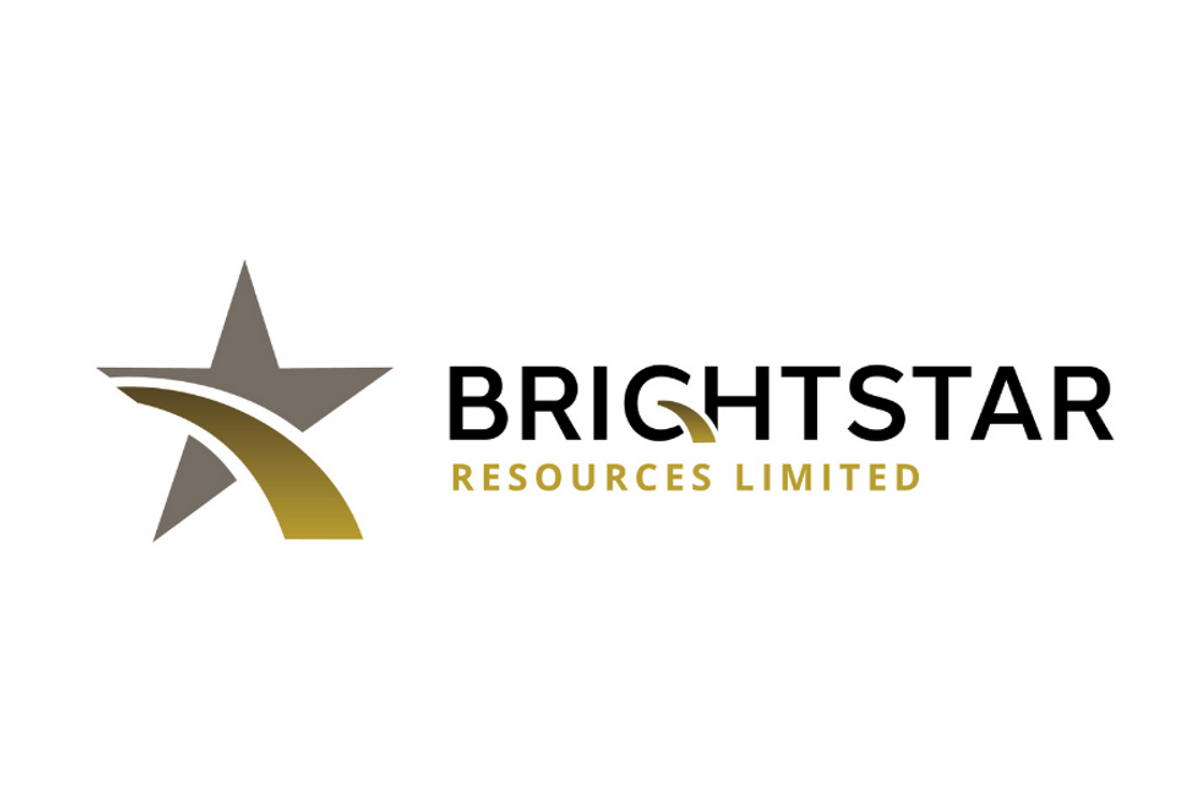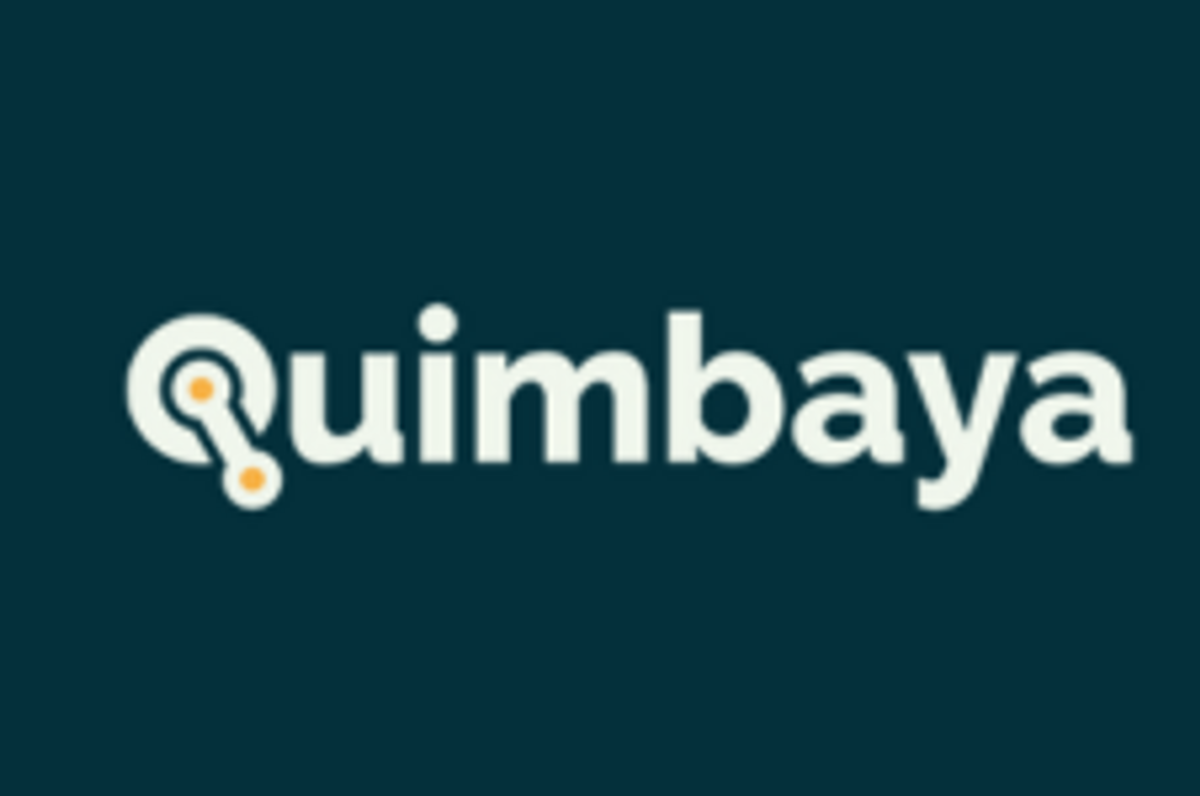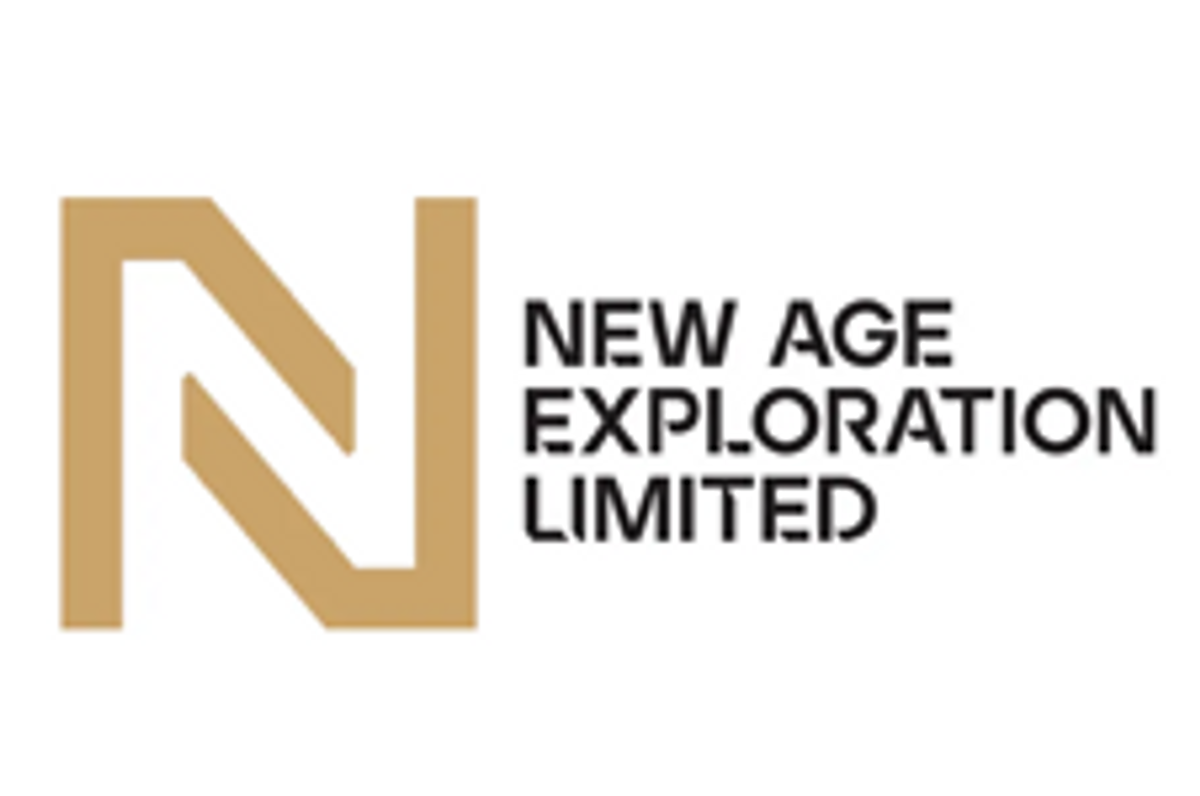
February 26, 2024
Brightstar Resources Limited (ASX: BTR) (Brightstar) is pleased to announce the second round of priority assay results from the remaining two metallurgical diamond drillholes at Cork Tree Well (CTW) within the Laverton Gold Project (LGP). These two holes were part of a broader 20 hole diamond drilling program1 which has now been successfully completed.
HIGHLIGHTS
- Assays received from the final two metallurgical diamond holes completed at Cork Tree Well with bonanza-grade gold assays up to 1028.37g/t Au
- High-grade results substantiated by numerous observations of visible gold in both drill holes
- Intercepts returned include 27.6m @ 17.77g/t Au from 51m (CTWMET003)
- CTWMET003 was drilled into the unmined central deposit at Cork Tree Well, with the gold mineralisation entirely contained within a dolerite - quartz breccia unit
- Intercepts returned below the historical shallow open pit within CTWMET001 include:
- 11.4m @ 3.1g/t Au from 133.5m (estimated true width), and
- 8.3m at 1.45g/t Au from 120.7m (estimated true width)
- Twenty-hole diamond drilling program successfully concluded with metallurgical and geotechnical testwork underway to feed into PFS workstreams
Brightstar’s Managing Director, Alex Rovira, commented “It is great to see further high-grades assays continuing and visible gold being observed from the diamond drilling program that has recently been completed at Cork Tree Well. CTWMET003 returned an excellent high-grade, shallow intersection of 27.6m @ 17.77g/t Au from 51m, which complements the previously announced2 intersections which included a strong result of 34.4m @ 7.94g/t Au (CTWMET004) drilled 1km to the north.
The drilling campaign represented the first diamond holes drilled at Cork Tree Well by Brightstar, with our understanding of the geology and mineralisation styles being strengthened by the knowledge being gained from this recently completed program.
Today’s results continue to reinforce our view that the gold mineralisation at Cork Tree Well is structurally hosted, with a mafic metadolerite host rock observed in CTWMET003 whilst gold mineralisation returned in CTWMET001 is positioned within the sedimentary package underneath the historically mined shallow open pit.
The four metallurgical drillholes (CTWMET001 – 004) were drilled into the known orebody locations that fall within the optimised $2,750/oz pit shells generated in the 2023 Scoping Study3, with CTWMET003 and CTWMET004 drilled down plunge to the orebody to deliver maximum rock mass for metallurgical testwork and CTWMET001 and CTWMET002 drilled perpendicular to the orebody and represent estimated true width.
Given the calibre of the assays received from the drilling to date, Brightstar continues to see strong potential to build on the existing 303koz @ 1.4g/t Au Mineral Resource4 both at depth with high-grade plunging shoots and strike extensions targeting the structurally-controlled mineralised trends. The high-grade results returned to date are significantly higher than the current 1.4g/t Au head grade of the Mineral Resource and 1.85g/t mine grade from the 2023 Scoping Study, representing significant upside.
We look forward to updating shareholders with more information on the diamond program, which forms the basis for metallurgical and geotechnical testwork workstreams within our ongoing Pre-Feasibility Study5.
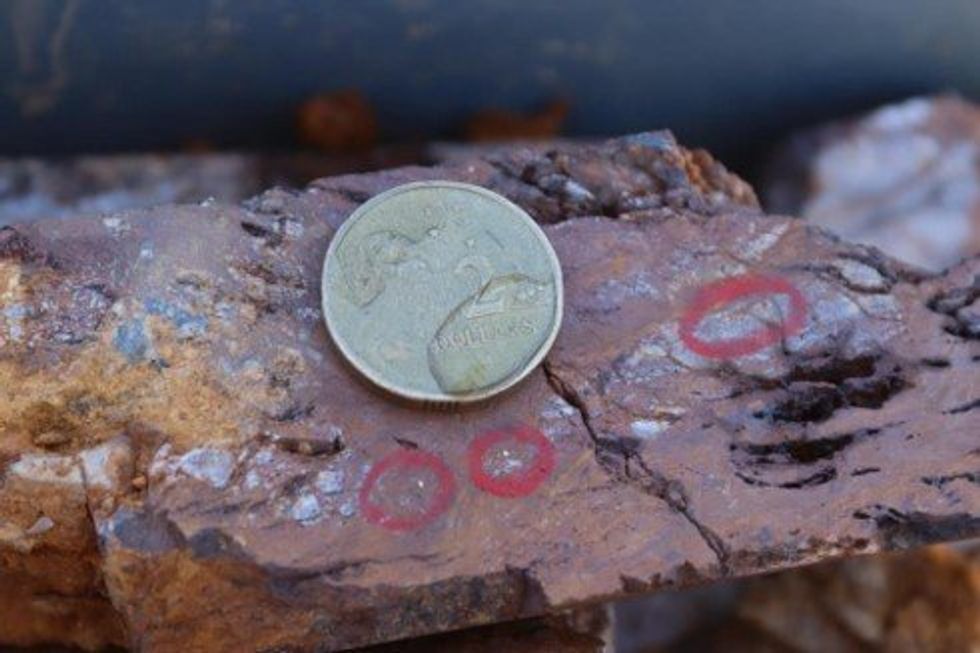
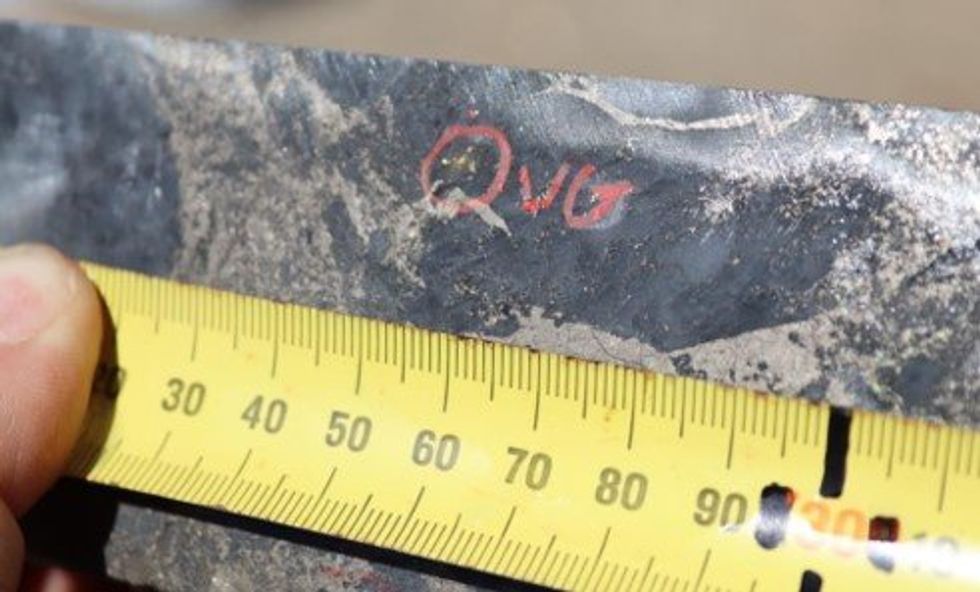
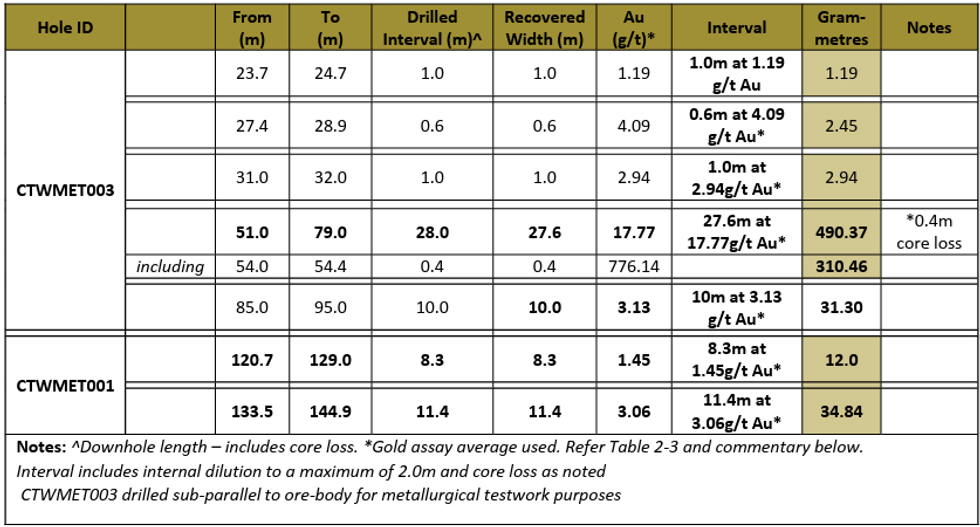
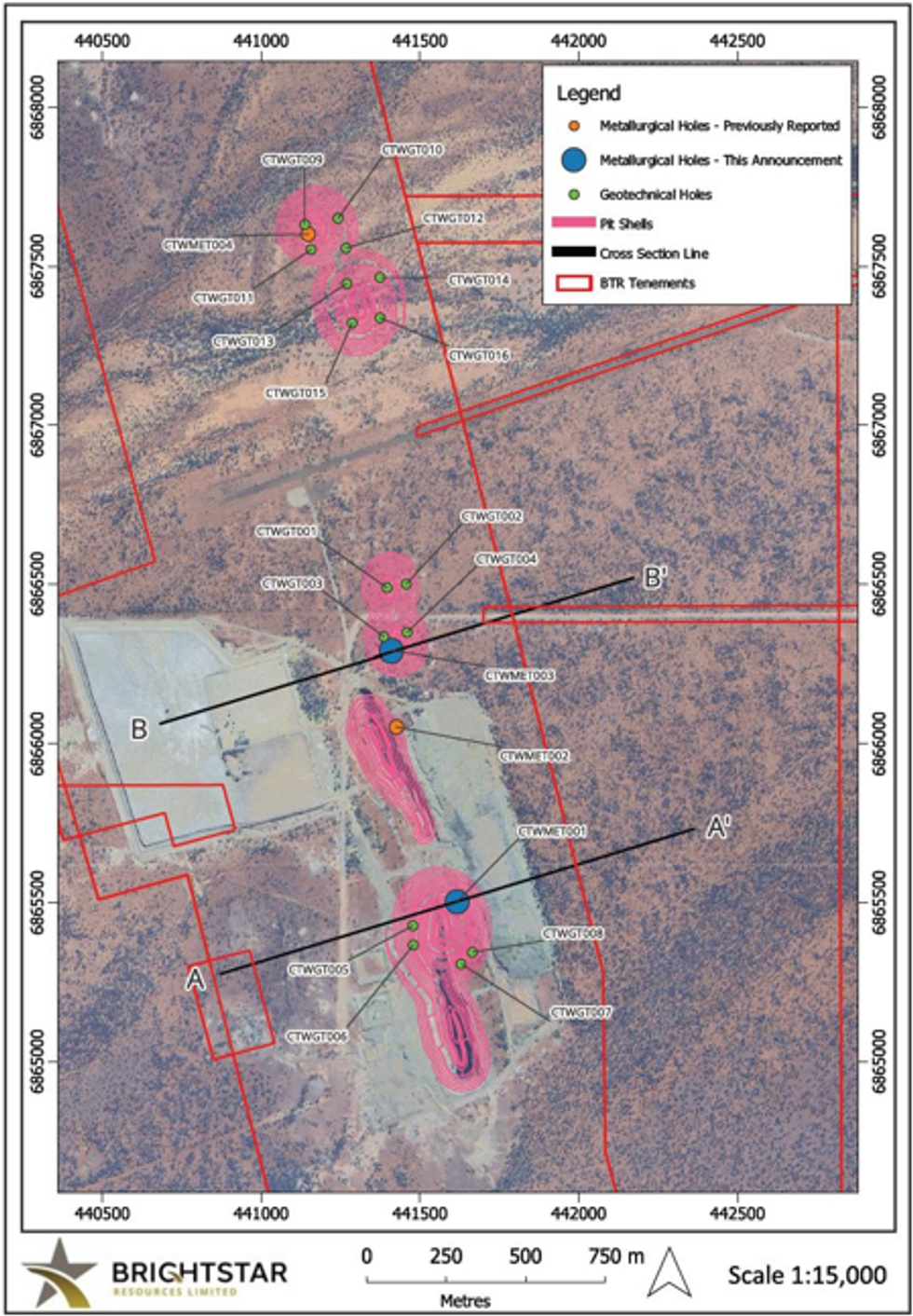
Due to the nuggety and high-grade nature of the gold mineralisation observed in CTWMET001 and CTWMET003, multiple samples had repeat assays completed following from best QA/QC laboratory practice. The repeat fire-assays provided additional analytical insight into the nuggety nature of mineralisation in addition to the visible gold observed. Where multiple repeat assay runs occurred, an average of the results has been used in the reporting in Table 1 above and within this announcement. The full breakdown of the re-assayed samples are outlined below in Table 2-3.
Click here for the full ASX Release
This article includes content from Brightstar Resources, licensed for the purpose of publishing on Investing News Australia. This article does not constitute financial product advice. It is your responsibility to perform proper due diligence before acting upon any information provided here. Please refer to our full disclaimer here.
BTR:AU

Sign up to get your FREE
Brightstar Resources Investor Kit
and hear about exciting investment opportunities.
- Corporate info
- Insights
- Growth strategies
- Upcoming projects
GET YOUR FREE INVESTOR KIT
The Conversation (0)
19 June
Brightstar Resources
Investor Insight
With multiple catalysts ahead, including resource upgrades, expanded production, and further development of its Laverton, Menzies, and Sandstone hubs, Brightstar Resources presents a compelling investment case in a rising gold market.
Overview
Gold has continued to demonstrate its resilience as a store of value, with prices peaking at US$3,500.05 per ounce, its all-time high. Amid ongoing global economic uncertainty, including inflationary pressures, rising geopolitical tensions, and volatile interest rate environments, investors have turned to gold as both a safe haven asset and a hedge against macroeconomic instability.
Brightstar Resources (ASX:BTR) is strategically positioned to capitalize on this environment as a low-cost, multi-asset gold developer with near-term production potential. The company controls over 1,500 square kilometers of highly prospective ground across three of Western Australia’s most prolific gold belts: the Laverton Tectonic Zone, the Menzies Shear Zone, and the Sandstone Greenstone Belt.
Unlike many junior exploration companies, Brightstar has a key differentiator: it owns a fully permitted, strategically located processing facility near Laverton. This existing infrastructure offers the company a critical advantage, enabling a low-capex restart scenario and faster time to cash flow compared to peers who must first secure permits and fund costly plant construction. This plant is subject of a DFS due for announcement in June 2025.
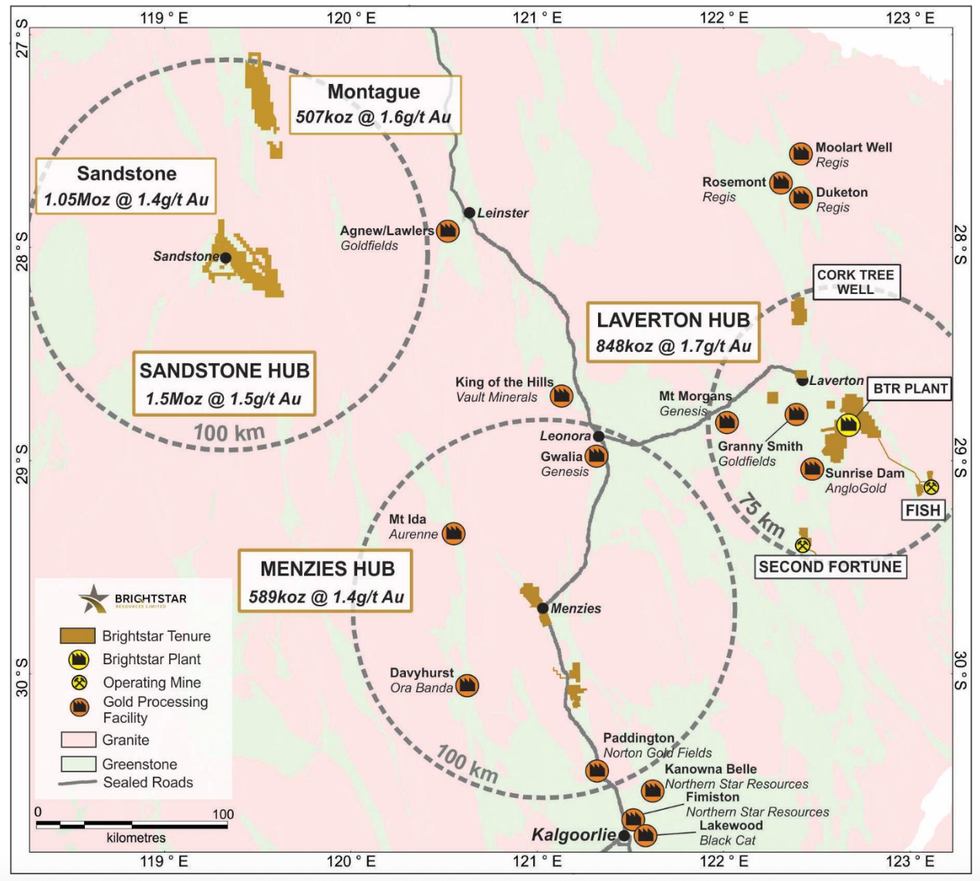
Through a focused multi-hub strategy, Brightstar has built a robust pipeline of development-ready and resource-growth projects, supported by:
- Over 3 million ounces of gold resources across Laverton, Menzies, and Sandstone;
- Ongoing high-grade drilling success in 2024 and 2025, including intercepts of up to 10m @ 43.8 g/t gold;
- A track record of low-cost, value-accretive acquisitions, such as Linden Gold Alliance and Alto Metals;
- A dedicated, in-house technical team executing on aggressive exploration, fast-tracked studies, and staged development.
With global gold demand remaining strong, Brightstar is well-positioned to deliver material shareholder value through its integrated production plan, supported by scalable infrastructure, a growing resource base, and access to capital. The company’s strategic approach includes combining brownfields development, organic exploration, and corporate M&A, placing it at the forefront of a new generation of Australian gold producers.
Company Highlights
- ASX-listed gold exploration and development company with a consolidated mineral endowment of 3 Moz of gold across Laverton, Menzies, and Sandstone hubs in Western Australia.
- Owns and operates 100 percent of project areas: 300 sq km in Laverton Tectonic Zone, 80 sq km in Menzies Shear Zone, and 1,200 sq km in Sandstone Greenstone Belt.
- Gold processing operations at the Laverton facility have commenced under an Ore Purchase Agreement (OPA) with Genesis Minerals Ltd (ASX:GMD), marking a significant milestone in transitioning from exploration to production.
- Recent drilling campaigns have yielded strong high-grade results, including:
- 16m @ 8.0 g/t gold at Second Fortune (Laverton)
- 10m @ 43.8 g/t gold at Musketeer (Sandstone)
- 16m @ 8.0 g/t gold at Yunndaga (Menzies)
- Following the successful Linden Gold Alliance acquisition, Brightstar has commenced a DFS for the wider development of its Laverton and Menzies assets which is due for release imminently in June 2025.
- Ongoing Sandstone drilling continues to return high-grade intercepts, further supporting project advancement and MRE conversion.
- In 2024, Brightstar signed a $4 million drill-for-equity deal with Topdrill to fast-track exploration at Sandstone.
- The company has successfully executed a US$11.5 million (AU$18 million) revolving stockpile finance facility with Ocean Partners Australia.
Key Projects

Laverton Hub
Brightstar’s Laverton hub is comprised of the Cork Tree Well, Jasper Hills, Second Fortune, Beta and Alpha project areas.
Highlights:
- Combined, the Laverton Hub JORC mineral resource estimate is 15.7 Mt @ 1.7 g/t gold for 848 koz (49 percent measured and indicated category). All mineral resources are on granted mining leases
- Cork Tree Well (6.4 Mt at 1.4 g/t gold for 292 koz gold)
- Alpha (1.4 Mt at 2.3 g/t gold for 106 koz gold)
- Beta (1.9 Mt at 1.7 g/t gold for 102 koz gold)
- Lord Byron (5.2 Mt at 1.5 g/t gold for 251 koz gold)
- Fish (376 kt at 4.0 g/t gold for 49 koz gold)
- Second Fortune (92 kt at 13.4 g/t gold for 40 koz gold)
- Gilt Key (168 kt at 1.3 g/t gold for 8 koz gold)
- Main project area Cork Tree Well is open at depth and along strike with recent drilling results of 34.4 meters at 7.94 g/t gold from 43.5 meters (CTWMET004) and 27.6 meters at 17.8 g/t gold from 51 m (CTWMET003)
- Second Fortune has a mineral resource estimate head grade of ~11g/t gold with an average ore body width of 0.6 meters.
- Jasper Hills is located 50 km from Brightstar’s existing processing facility along a wholly-owned private haul road, allowing unimpeded, direct access to both projects
- Permitted, previously mined and production-ready
- Last mined by current owners in 2020 with 23,000 oz gold mined
- Growth Drivers:
- Second Fortune: Consistent, stable production and cash generation through 2025
- Fish: Mining activities have commenced and site establishment is continuing.
- First ore production targeted in June
- Open pits development: Large scale production opportunities through mining Lord Byron and Cork Tree Well as multi-year base load ore sources
- DFS: due for delivery in June 2025, including design and costs for expansion of BTR-owned processing infrastructure to 1Mtpa.
Menzies Hub
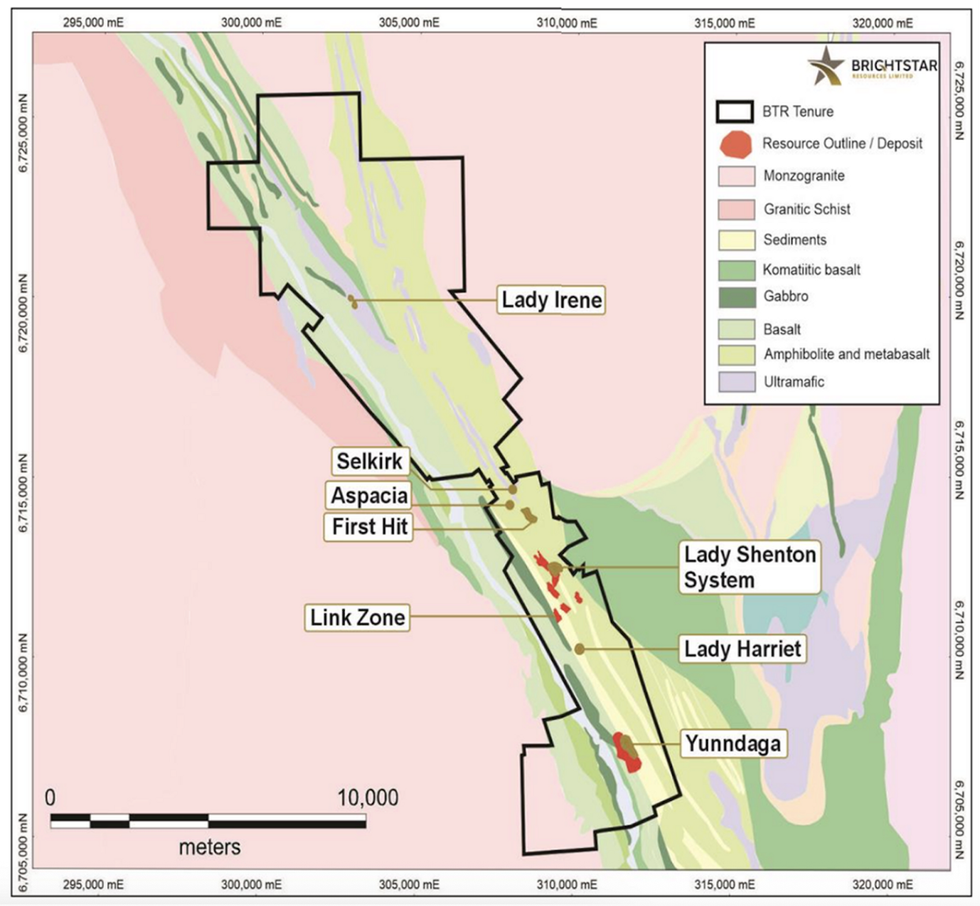
The Menzies Hub comprises a tenement holding of a contiguous land package of granted mining leases over a strike length of more than 20 km. The majority of deposits hosted along the Menzies Shear Zone are located adjacent to the Goldfields Highway in Menzies (130km north of Kalgoorlie).
Highlights:
- Total Current Resource: 12.7 Mt at 1.4 g/t gold for 589 koz gold (37 percent measured and indicated)
- DFS: due for delivery in June 2025, including design and costs for open pit and underground mining for toll processing/ore sales to a regional Kalgoorlie-Menzies mill.
- Growth Drivers:
- Lady Shenton Open Pit: Proposed multi-year consistent open pit production to provide cash generation. Targeting approvals received and ‘mine ready’ in 2025
- Yunndaga Underground: Planned infill drilling targeting conversion of Inferred Mineral Resources to M+I to support inclusion in future mining operations – recent results from this program include 16m @ 8.0 g/t gold
- Development: Advancing discussions with regional mills for 3rd party processing capacity in the Kalgoorlie-Menzies region, targeting a mining decision.
Sandstone Hub
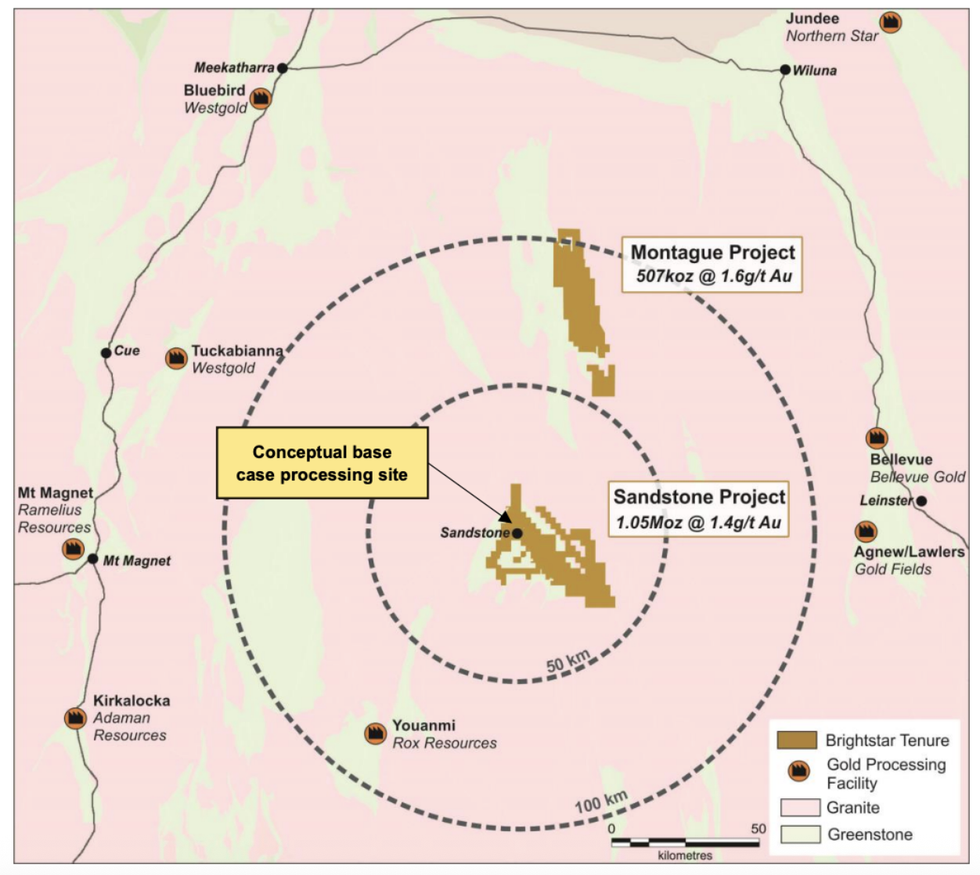
The consolidated Sandstone project is over 100 km from existing third-party milling operations in the Murchison. This third processing hub boasts Alto’s Sandstone project with a mineral resource of 1.05 Moz at 1.4 g/t gold and Gateway’s Montague gold project with a mineral resource of 0.5 Moz @ 1.6 g/t gold.
Growth Drivers:
- Sandstone: Upgrade the Lords, Vanguard, Indomitable and Havilah camps to Indicated classification (40,000m RC+DD)
- Montague: Infill Montague and Whistler to Indicated classification (5,000m RC and 1,200m DD) – RC
- Greenfields: Follow up drilling of priority prospects across Sandstone Hub (West Hacks, Hancocks, Bulchina, Lords Corridor, Duplex) – recent drilling success includes exceptional intercepts at the Musketeer prospect yielding 10m @ 43.8 g/t gold
- Pre-Feasibility Study: Incorporation of 2025 drilling results into MRE upgrades to then factor into 1H 2026 Sandstone PFS
Management Team
Alex Rovira - Managing Director
Alex Rovira is a qualified geologist and an experienced investment banker having focused on the metals and mining sector since 2013. Rovira has experience in ASX equity capital markets activities, including capital raisings, IPOs and merger and acquisitions.
Richard Crookes - Non-executive Chairman
Richard Crookes has over 35 years’ experience in the resources and investments industries. He is a geologist by training having previously worked as the chief geologist and mining manager of Ernest Henry Mining in Australia.
Crookes is managing partner of Lionhead Resources, a critical minerals investment fund and formerly an investment director at EMR Capital. Prior to that he was an executive director in Macquarie Bank’s Metals Energy Capital (MEC) division where he managed all aspects of the bank’s principal investments in mining and metals companies.
Andrew Rich - Executive Director
Andrew Rich is a degree qualified mining engineer from the WA School of Mines and has obtained a WA First Class Mine Managers Certificate. Rich has a strong background in underground gold mining with experience predominantly in the development of underground mines at Ramelius Resources (ASX:RMS) and Westgold Resources (ASX:WGX).
Ashley Fraser - Non-executive Director
Ashley Fraser is an accomplished mining professional with over 30 years experience across gold and bulk commodities. Fraser was a founder of Orionstone (which merged with Emeco in a $660-million consolidation) and is a founder/owner of Blue Cap Mining and Blue Cap Equities.
Jonathan Downes - Non-executive Director
Jonathan Downes has over 30 years’ experience in the minerals industry and has worked in various geological and corporate capacities. Experienced with gold and base metals, he has been intimately involved with the exploration process through to production. Downes is currently the managing director of Kaiser Reef, a high grade gold producer, and non-executive director of Cazaly Resources.
Dean Vallve – Chief Development Officer
Dean Vallve holds technical qualifications in geology & mining engineering from the WA School of Mines, an MBA, and a WA First Class Mine Managers Certificate. Vallve was previously in senior mining and study roles at ASX listed mid-cap resources companies Hot Chili (ASX:HCH) and Calidus Resources (ASX:CAI).
Nicky Martin – Chief Financial Officer
Nicky Martin is an experienced finance and accounting professional holding tertiary qualifications in accounting and finance and is a qualified CPA. Martin was previously the Head of Finance at Pilbara Minerals Ltd (ASX:PLS) where she oversaw and was actively involved in a rapidly growing mining success story.
Keep reading...Show less
Emerging gold producer and district-scale resource developer in Western Australia
02 July
High grade gold in early stage drilling at Sandstone
30 June
Merger Discussions Between Brightstar and Aurumin
29 June
Menzies and Laverton Gold Projects Feasibility Study
13h
Maritime Resources
Investor Insight
With a fully permitted, high-grade gold project, established infrastructure and first gold production on the horizon, Maritime Resources is set to become Atlantic Canada’s next gold producer, positioning the company for significant re-rating and long-term growth.
Overview
Maritime Resources (TSXV:MAE) is a Canadian gold development company focused on generating near-term cash flow from the Hammerdown gold project, a high-grade past-producer in the prolific Baie Verte mining district of Newfoundland & Labrador. The project is fully permitted, de-risked and shovel-ready, with construction underway and first ore deliveries to the Pine Cove Mill expected in late summer to early fall 2025.
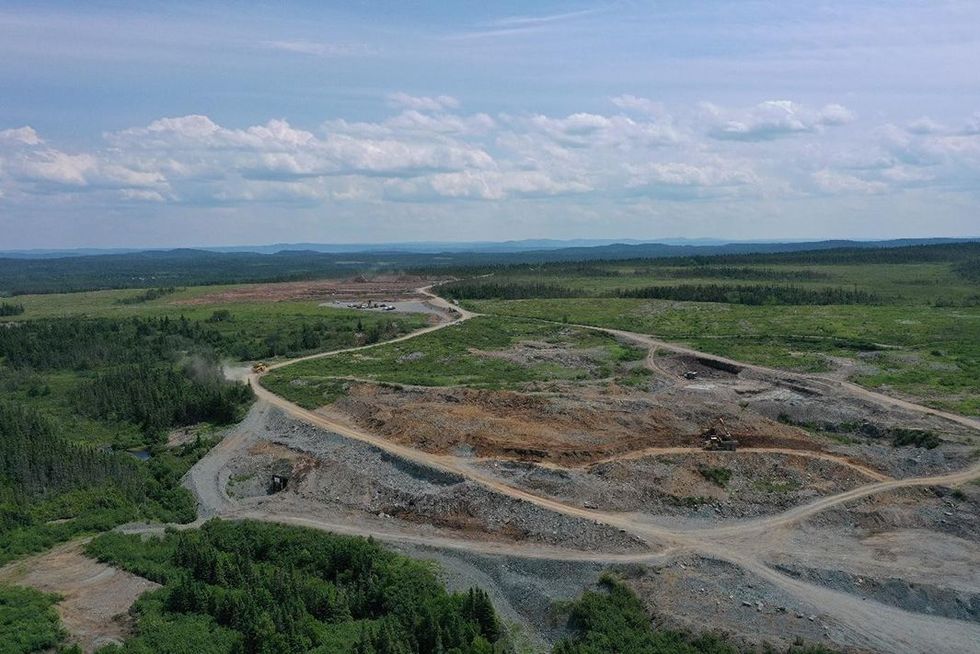
Hammerdown project site
Hammerdown benefits from significant infrastructure synergies, including proximity to paved roads, power, ports and Maritime’s wholly owned Pine Cove processing facility. Unlike many greenfield developers, Maritime is executing a bootstrap production model that leverages its installed infrastructure and local skilled labor to reduce costs, minimize risk and accelerate value creation through short term cash flow generation during a period of record high gold prices
Longer term, the company plans to build out a 100,000 oz/year production platform by incorporating nearby deposits (Orion, Stoger Tight, Deer Cove) and utilizing its idle 700 tpd Nugget Pond gold plant. Maritime’s regional land package includes more than 435 sq km of highly prospective ground with gold, VMS, and porphyry-style mineralization potential.
Company Highlights
- Near-term Gold Production: First production targeted for H2/2025 from the fully permitted Hammerdown open pit project.
- High-grade Gold Reserves: 1.9 Mt at 4.46 g/t gold (272 koz) proven and probable reserves support initial 35,000-45,000 oz/year production.
- Low-CAPEX Startup: Initial capital estimated at C$15 to $20 million, among the lowest in the sector for a new mine, leveraging Maritime’s fully operational Pine Cove mill
- Owned Processing Infrastructure: Pine Cove Mill (1,300 tpd, operational) and the Nugget Pond gold plant (700 tpd CIP circuit, on standby).
- Exploration Upside: 435 sq km land package includes multiple brownfield and greenfield targets proximal to infrastructure.
- Institutional Backing: Strong support from Dundee Corporation, Eric Sprott and other institutions.
- Fully Funded: recently closed $20 million hard dollar financing and $10 million private placement (live) to fund mine startup and repay the existing US$5 million note.
- Local Workforce Advantage: Fully staffed Pine Cove Mill with 100 percent local residents
Key Projects
Hammerdown Gold Project

The Hammerdown gold project is Maritime’s flagship asset and is strategically located near the town of King’s Point in the Baie Verte mining district of Newfoundland and Labrador. A past-producing, high-grade deposit formerly operated by Richmont Mines, Hammerdown is being redeveloped as a shallow open-pit operation. The project hosts proven and probable reserves of 1.89 million tonnes at an average grade of 4.46 grams per ton (g/t) gold for 272,000 oz of contained gold, making it one of the highest grade open pit projects in North America
A feasibility study completed in 2022 outlined annual production of approximately 50,000 oz over a 5-year mine life, with attractive economics including a pre-tax NPV (5 percent) of US$251 million at a gold price of US$2,500/oz and an all-in sustaining cost (AISC) of US$912/oz. Since then Maritime has taken steps to de-risk the project including acquiring the Pine Cove mill, allowing for significant savings in capital costs compared to using the Nugget Pond mill.
The processing plan entails crushing ore on site and trucking it approximately 130 km to the Pine Cove Mill. Maritime has completed all major permitting for the project, and construction began in spring 2025 with pre-stripping, civil works and crushing infrastructure installation. The company completed more than 8,750 meters of tight-spaced (10x10 meters) grade control drilling, confirming excellent continuity and high-grade intercepts such as 24.5 g/t gold over 13.9 meters, including 42.2 g/t over 8.0 meters. First gold production is expected in late summer to early fall 2025, with ramp-up to 700 tpd mill feed supported by the fully operational Pine Cove Mill.
Pine Cove Mill

Pine Cove gold pour
Located near Baie Verte, the Pine Cove Mill is a 1,300-ton-per-day gold processing facility recently brought back online after two years of care and maintenance. The mill flowsheet includes crushing, grinding, flotation, regrinding of the float concentrate and Merrill-Crowe leaching circuits for gold doré production. The facility will be upgraded with a new 500 hp regrind circuit (replacing a 150 hp unit), a ball mill inching drive, and an enhanced material handling system to optimize recovery and reliability. The site also includes a large in-pit tailings storage facility, existing waste dump capacity, and access to a deepwater port. Pine Cove has already produced 700oz of gold from processing low grade mineralized stockpiles from around the site. The mill is now preparing to receive and process feed from Hammerdown, with full integration scheduled for H2/2025.
Nugget Pond Gold Circuit

Nugget Pond Gold Circuit
Maritime also owns the 700 tpd carbon-in-pulp (CIP) gold circuit at the Nugget Pond Plant, located 40 km east of Pine Cove. Although currently idle, this plant represents a key component of Maritime’s long-term production strategy to scale toward 100,000 oz per year. The plant is fully configured for gold recovery and is well-positioned to process feed from future regional deposits or third-party toll milling. Maritime’s envisions Nugget Pond operating as a second production hub, enabling parallel processing capacity as the company develops additional deposits in the district.
Stoger Tight and Deer Cove Projects
Located within 10 km of the Pine Cove Mill, Stoger Tight and Deer Cove are advanced-stage deposits with near-term development potential. Stoger Tight hosts a historical NI 43-101 resource of 642,000 tons grading 3.02 g/t gold for 62,300 oz (indicated), with an additional 53,000 tons at 5.63 g/t for 9,600 oz (inferred). It is partially permitted and has the potential to become a satellite source of ore for Pine Cove.
Deer Cove is a high-grade system discovered by Noranda, featuring 500 meters of historic underground development. Recent drill results include 6.9 g/t over 25.1 meters, including 26.1 g/t over 3.6 meters. Stockpiles of 4,275 tons at 3.1 g/t gold have been identified. Both projects benefit from road access and proximity to infrastructure, making them ideal candidates for phased development and integration into Maritime’s hub-and-spoke production model.
Green Bay, Whisker Valley and El Strato Exploration Projects
Maritime’s broader exploration portfolio includes more than 435 sq km of prospective ground in the Baie Verte district, encompassing gold, copper, VMS and porphyry-style targets. The Green Bay project includes the Orion deposit, a near-surface gold target located along strike from Hammerdown. Whisker Valley is an epithermal gold system with porphyry potential, returning 6.2 g/t gold over 5.8 meters in previous drilling. El Strato hosts one of the highest-grade soil and bedrock anomalies in Newfoundland, with gold values up to 200 g/t in outcrop. Additionally, the Black Ridge VMS target features grab samples grading up to 12.6 g/t gold, 181 g/t silver, and 11.8 percent copper. These regional assets offer significant blue-sky potential and provide a robust pipeline of targets that could be developed and processed through Maritime’s existing infrastructure.
Management Team
Garett Macdonald – President and CEO
Garett Macdonald is a mining engineer with over 30 years of experience in mine development, engineering and operations. Former VP operations at Rainy River Resources, where he advanced the 8 Moz Rainy River project to construction prior to its $310-million sale to New Gold. He also served as VP project development at JDS Mining, leading the Curraghinalt feasibility study (+5 Moz gold), and held technical and management roles at Placer Dome, Teck and Suncor Energy.
Germaine M. Coombs – CFO and Corporate Secretary
A chartered accountant with more than three decades of financial leadership in the mining sector, Germaine M. Coombs is the former CFO of Aurelius Minerals and Stonegate Agricom, and former corporate controller at FNX Mining and the Iron Ore Company of Canada.
Perry Blanchard – VP, Environment & Sustainability
Perry Blanchard brings over 25 years of experience in health, safety and environmental leadership across major Canadian mining projects. Blanchard previously managed permitting and sustainability at Detour Gold’s flagship mine and Vale’s Voisey’s Bay operations.
Peter Goudie – Hammerdown Operations Manager
Peter Goudie is a veteran operations leader with over 35 years of experience in mining and contracting, including roles with Guy J. Bailey and Shoreline Aggregates. He manages day-to-day operations at the Hammerdown project, with deep knowledge of logistics, mobile equipment and site execution in Newfoundland’s mining sector.
Dwight Goudie – Pine Cove Mill Manager
Dwight Goudies is a mill operations specialist with over 40 years of metallurgical and processing experience at gold and base metal mines across Newfoundland and Labrador. He is the former mill manager at FireFly Metals and Rambler Metals & Mining’s Nugget Pond facility, and currently oversees all operations at the Pine Cove Mill.
Billy Grace – Chief Engineer
A mining engineer with more than 15 years of experience in mine engineering, project management and consulting, Billy Grace is the former general manager at Aureus Gold, and technical services manager at Newmont’s Musselwhite mine. He also worked at Golder Associates and Mining Plus.
Larry Pilgrim – Project Manager, Newfoundland Properties
Larry Pilgrim is an exploration geologist with more than 45 years of experience in Newfoundland. He is the former chief geologist at Richmont Mines and Rambler Metals, where he helped delineate the original underground reserves at Hammerdown and served as chief geologist during mine operations. He has been leading exploration activities for Maritime since 2018.
Eric Tremblay – Technical Advisor Mining
Eric Tremblay is a highly regarded mine builder with over 30 years of operations experience. He is the former GM at Osisko’s Canadian Malartic Mine and IAMGOLD’s Westwood and Sleeping Giant operations. Tremblay is currently the COO of Dalradian Resources, leading the multi-million ounce Curraghinalt gold project in Northern Ireland. Tremblay provides Maritime with expertise in mine construction, operational scale-up and technical risk management.
Paolo Toscano – Technical Advisor Engineering and Construction
Paolo Toscano has over 30 years of experience in engineering and construction. He most recently served as senior vice-president of engineering and construction for Calibre Mining at the Valentine gold project in Newfoundland and Labrador. Prior to Calibre, he was director of projects for Alamos Gold and New Gold.
Keep reading...Show less
14h
Triumph Gold
Investor Insight
Triumph Gold offers investors exposure to a multi-million ounce gold resource base with established deposits, significant expansion potential, and new discovery opportunities across a true district-scale land package, all strategically positioned in the mining-friendly Yukon.
Overview
Triumph Gold (TSXV:TIG,OTC:TIGCF) is a Canadian gold exploration company strategically positioned to capitalize on the rising gold market. The company is primarily focused on advancing its 100 percent owned Freegold Mountain project, a district-scale property located in the Yukon Territory's prolific Dawson Range gold-copper belt.
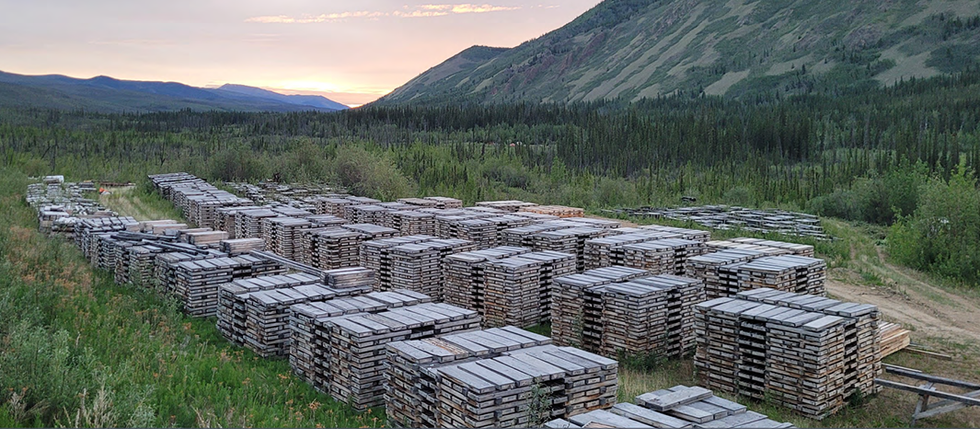
Founded with a vision to discover and develop significant precious metal resources, Triumph Gold has assembled a portfolio centered around its flagship Freegold Mountain project. With over 20 mineralized zones identified along a 34 km stretch of the Big Creek Fault system, the company possesses significant exploration upside with established resources across multiple deposits. The project benefits from excellent infrastructure, being accessible via all-weather government roads, which provides cost advantages compared to more remote exploration projects.
The Yukon Territory has a storied history as one of the world's most famous gold jurisdictions, dating back to the legendary Klondike Gold Rush of the late 1890s that drew over 100,000 prospectors to the region. Today, the territory continues to be recognized as one of the world's premier exploration destinations, hosting world-class deposits like Victoria Gold's Eagle mine (3.3 million ounces), Western Copper's Casino project (8.9 million ounces gold, 4.5 billion pounds copper), and Newmont's Coffee project (4 million ounces).
The Yukon government has consistently demonstrated strong support for responsible mining development. The territory offers a stable regulatory environment, clear permitting processes, and collaborative relationships with First Nations, making it an attractive jurisdiction for resource development. Additionally, the Yukon Resource Gateway Project, a $360 million infrastructure initiative, continues to improve access to mineral-rich areas throughout the territory.
With geopolitical tensions, inflationary pressures, and currency devaluation concerns driving investor interest in safe-haven assets, gold exploration companies with substantial resource potential like Triumph Gold are well-positioned to benefit from this strengthening market cycle.
Company Highlights
- Resource Base: Combined indicated resources of 1 million ounces and inferred resources of 1.08 million ounces gold equivalent across the Freegold Mountain project
- Strategic Location: Positioned in the mineral-rich Dawson Range, home to major deposits including Newmont's Coffee, Western Copper's Casino, and Pembridge's Minto mine
- Multiple Deposit Types: Mineralization found in various forms (porphyry, epithermal, skarn) providing diversified exploration targets
- Expansion Potential: All deposits remain open in multiple directions with numerous untested satellite targets
- Fully Permitted: Exploration permits in place until 2025-2026 allowing for extensive drilling programs
- Experienced Leadership: Management team with proven track records in mineral exploration, mine development and capital markets
Key Projects
Freegold Mountain Project
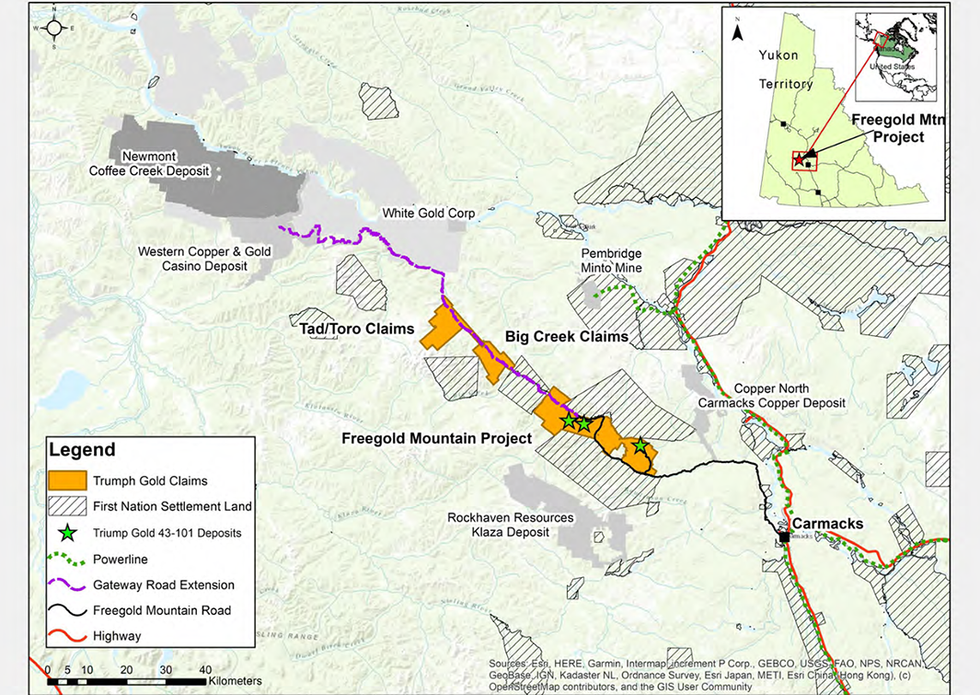
The Freegold Mountain project represents Triumph Gold's flagship asset – a district-scale property that spans 34 kilometers along the prolific Big Creek Fault mineralization system in the Yukon. What makes this project particularly compelling is the presence of mineralization in every rock type across the property, including Paleozoic metamorphics, Jurassic intrusives and Cretaceous intrusives, each hosting different styles of precious and base metal deposits.
The project currently hosts three defined deposits – Nucleus, Revenue and Tinta Hill – with a combined resource of more than 2 million ounces of gold equivalent. What's particularly exciting about Freegold Mountain is that these deposits represent just a fraction of the more than 20 mineralized zones identified across the property. With extensive permitted exploration programs, ongoing geological work, and vast untested areas, Freegold Mountain exemplifies true district-scale potential where new discoveries could substantially increase the overall resource base.
Nucleus Deposit
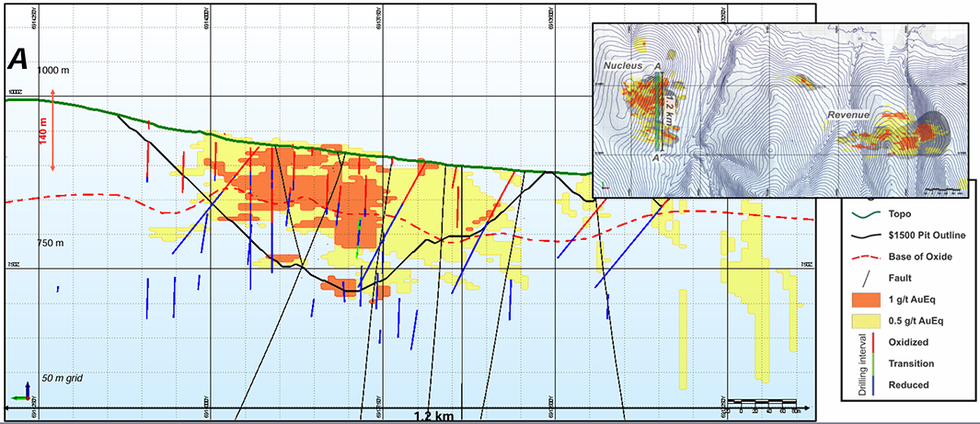
The Nucleus deposit represents a compelling bulk tonnage oxide gold opportunity with similarities to Victoria Gold's Eagle mine. With indicated resources of 748,000 ounces gold equivalent and inferred resources of 189,000 ounces gold equivalent, the deposit features favorable metallurgy with approximately 77 percent cyanide recoverable gold based on preliminary testing. Recent drilling has expanded the resource by 50 to 100 meters both laterally and vertically, with mineralization remaining open in all directions. Drilling has also confirmed significant oxide mineralization extending up to 150 meters vertically, enhancing the potential for heap leach processing.
Revenue Deposit
The Revenue deposit is a substantial porphyry system with indicated resources of 252,000 ounces and inferred resources of 677,000 ounces gold equivalent. It shows similarities to Western Copper's Casino deposit but with double the gold grade. The deposit contains multiple high-grade zones including the Blue Sky and WAu zones, which were expanded through recent drilling programs. The company has identified a more than 5 km structural trend connecting various mineralized zones, suggesting significant resource expansion potential. Geophysical and geochemical surveys have identified numerous untested anomalies worth exploring.
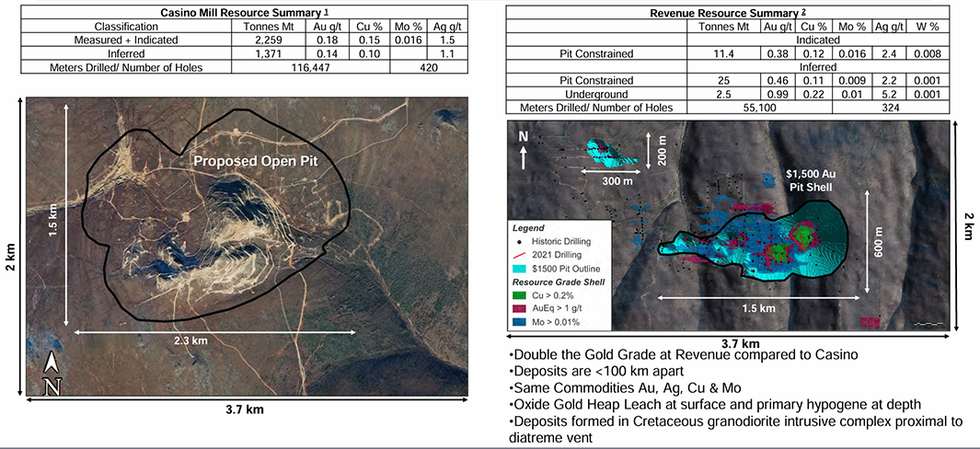
Revenue - Casino deposits comparison
Tinta Hill Deposit
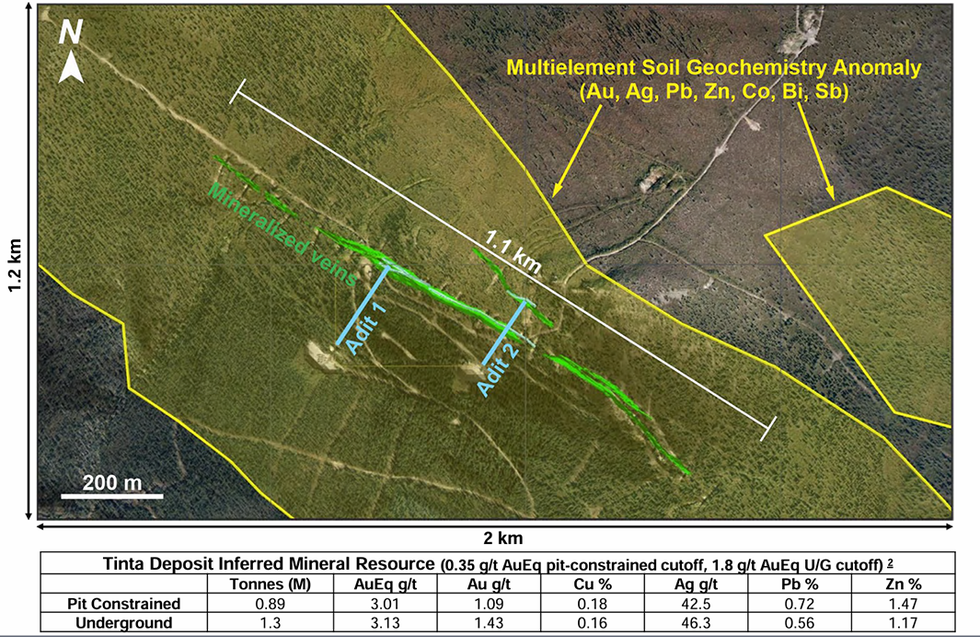
With inferred resources of 216,000 ounces gold equivalent, Tinta Hill is a polymetallic deposit with substantial gold, silver, copper, lead and zinc values. The property has historical underground development including two adits with extensive drifting completed in 1980-1981. There's a 25,000-ton stockpile from previous mining operations that could represent near-term cash flow potential. The deposit remains open along strike and at depth, with opportunities to extend mineralization through additional IP and ground magnetic surveys.
Exploration Properties
Beyond the three established deposits, Triumph Gold holds several promising early-stage exploration targets across the Freegold Mountain Project and beyond, including:
- Melissa Zone: A drill-ready target with similarities to the Nucleus deposit, featuring anomalous gold in rock samples and coincident multi-element soil and geophysical anomalies
- Tad/Toro-Big Creek: Located approximately 50 km southeast of the Casino deposit, showing intermediate sulfidation epithermal and porphyry-style mineralization across multiple zones
- Andalusite Peak: A copper-gold-silver porphyry target with three separate mineralized zones showing high-grade rock samples up to 68 percent copper, 2.77 grams per ton (g/t) gold, and 526 g/t silver
Coyote Knoll Silver-Gold Project
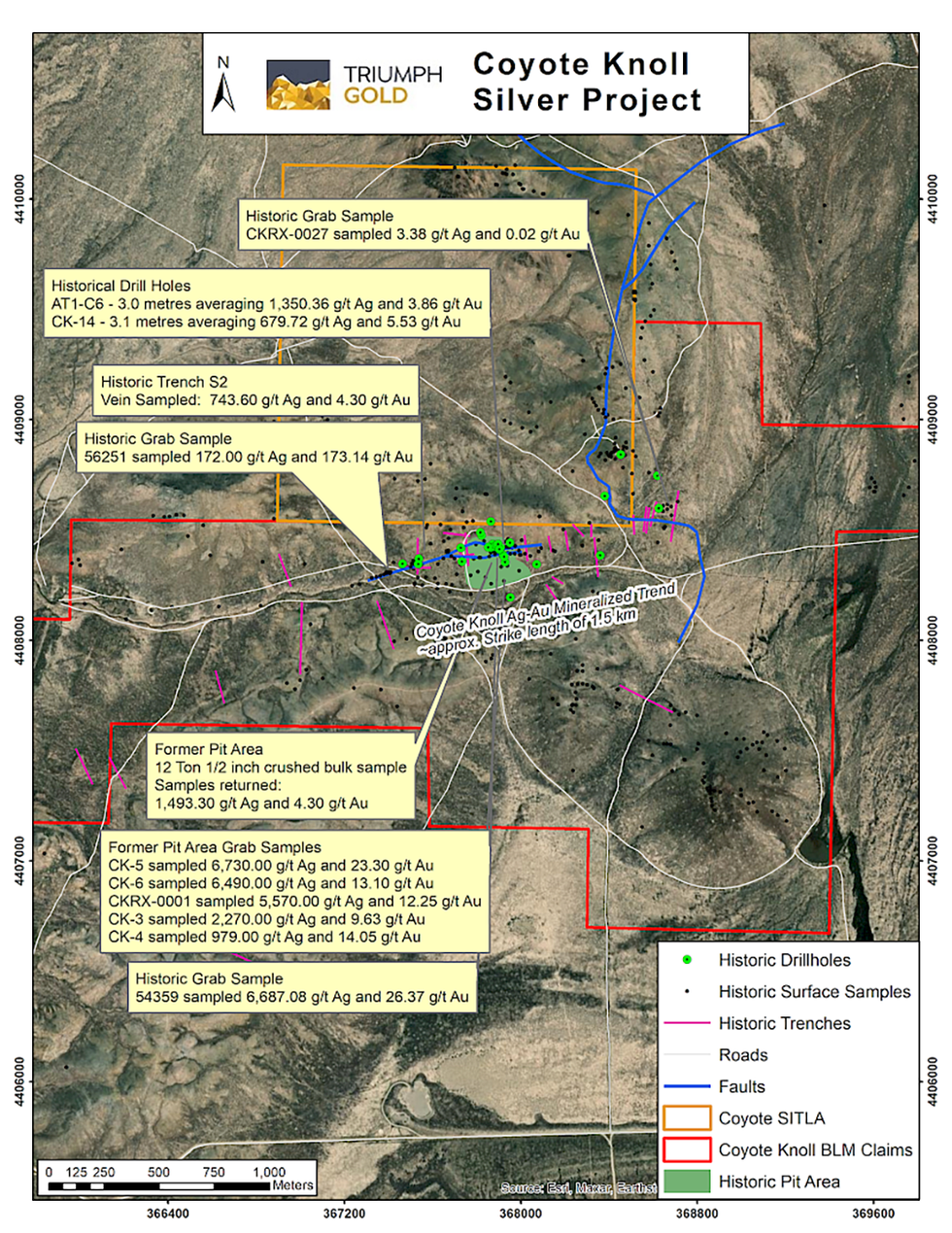
Located in central Utah, Coyote-Knoll is Triumph Gold’s most recent acquisition. It is approximately 40 km southwest of the prolific Tintic mining district, known for its rich mining history, with gold, silver, lead and zinc from both epithermal and carbonate replacement deposits. The Bingham Canyon copper-molybdenim-gold porphyry deposit is about 85 km away.
Following its discovery in 1988, Coyote Knoll underwent exploration work, including mapping, trenching, rock sampling, and induced polarization and magnetic geophysical surveys. Approximately 2,600 metres of RC drilling have been completed at the property to date, with compelling results including 1,350.36 g/t silver and 3.86 g/t gold over 3 metres. Historical rock samples returned high-grade silver and gold values, up to 6,730 g/t silver and 23.30 g/t gold, and 6,687.08 g/t silver and 26.37 g/t gold.
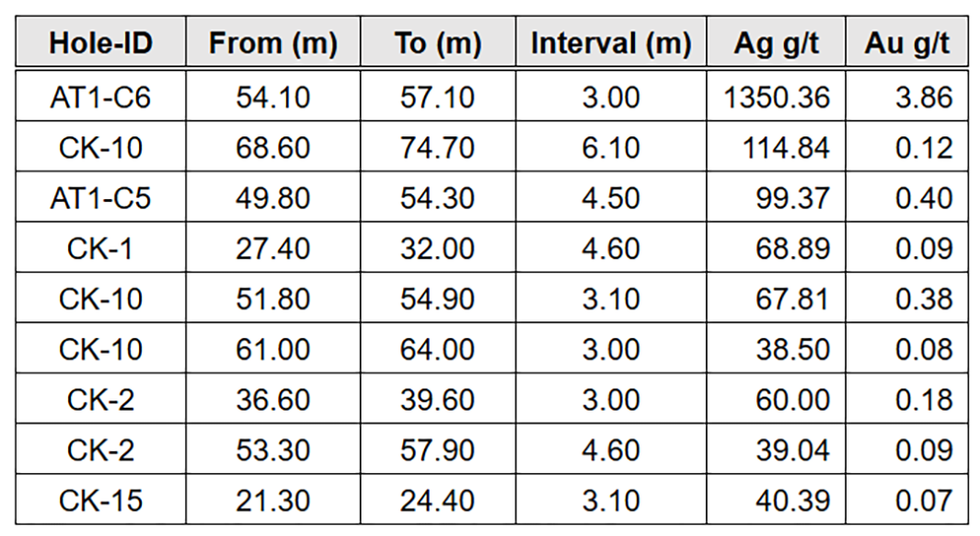
Historic drilling highlights at Coyote Knoll
A 12-ton representative bulk sample was also mined from a shallow open pit, centered over the east-west trending mineralized structure. Silver and gold epithermal mineralization was exposed over approximately 60 metres within the open pit and has been delineated for 1.5 km through surface trenching, sampling and shallow RC drilling.
Management Team
John Anderson – Interim CEO and Chairman
With over 20 years of experience in resource sector capital marketing, John Anderson brings strategic vision to company growth and management. His extensive background in capital formation and corporate development provides Triumph Gold with strong leadership as it advances its portfolio of projects.
Brian Bower – Lead Director
Brian Bower contributes 30 years of experience in exploration and mining to the Triumph Gold team. He has been a key member in the development of several significant mining projects including New Afton, Kemess South, Blackwater, Mount Milligan mines and the Casino deposit, bringing valuable technical and operational insights to the company's development strategies.
Jesse Halle – VP Exploration
With more than 25 years of experience in mineral exploration, Jesse Halle has specialized in advancing multiple porphyry copper-gold deposits in Yukon and British Columbia. His extensive work with similar deposits, including the Casino and Copper Mountain deposits, brings critical technical expertise to Triumph's exploration programs.
Marty Henning – Principal Geologist
Marty Henning contributes over 15 years of mineral exploration and mining experience to the team. His background includes focused work on construction, production and exploration at the New Afton block cave mine, providing valuable operational perspective to Triumph's exploration approach.
Graeme Hopkins – Chief Technical Officer
With 20 years of experience in data management and GIS, Graeme Hopkins has been involved with the Freegold Mountain project since 2008. His long-term knowledge of the project and technical expertise provides valuable continuity and insight to Triumph's exploration and development activities.
Emily Halle – Project Manager
Emily Halle brings over 15 years of experience in exploration and project management to the team. Her focus on porphyry copper-gold systems in British Columbia and Yukon, combined with additional experience in South Africa, Alaska and Eastern Canada, ensures efficient and effective management of Triumph's exploration programs.
Keep reading...Show less
08 July
Mark O'Byrne: Gold, Silver Prices Going Much Higher — How Much to Own?
Mark O'Byrne, managing director at Tara Coins, shares his outlook for gold and silver.
He sees much higher prices long term and expects gold to rise to at least US$10,000 per ounce; for silver, O'Byrne believes US$100 to US$150 per ounce is a "conservative" target.
Don't forget to follow us @INN_Resource for real-time updates!
Securities Disclosure: I, Charlotte McLeod, hold no direct investment interest in any company mentioned in this article.
Keep reading...Show less
08 July
Quimbaya Gold
Investor Insight
Quimbaya Gold’s strategic focus on Colombia offers a compelling opportunity for gold exploration in a prolific, yet underexplored region supported by a favorable permitting environment. The upside potential is worthy of examination by any savvy investor.
Overview
Quimbaya Gold (CSE:QIM) is a junior gold exploration company focused on its high-grade gold projects in Colombia. The company’s portfolio spans 59,057 hectares across three highly prospective regions in the Antioquia mining district. This region is responsible for approximately 50 percent of Colombia’s total gold production, equivalent to around 1 million ounces (Moz) annually.
Positioned right next to Aris Mining’s (TSX:ARIS) Segovia mine, Quimbaya leverages its proximity to established infrastructure and gold-rich geological formations. With Colombia being one of the most underexplored yet top mining jurisdictions in South America, Quimbaya’s projects are uniquely poised for significant discoveries.
Quimbaya’s projects benefit from Colombia’s favorable permitting environment, enabling faster transitions from discovery to production, compared to its global peers. Quimbaya’s strategy focuses on value creation through new discoveries and monetizing them via strategic transactions, including joint ventures and operational contracts.
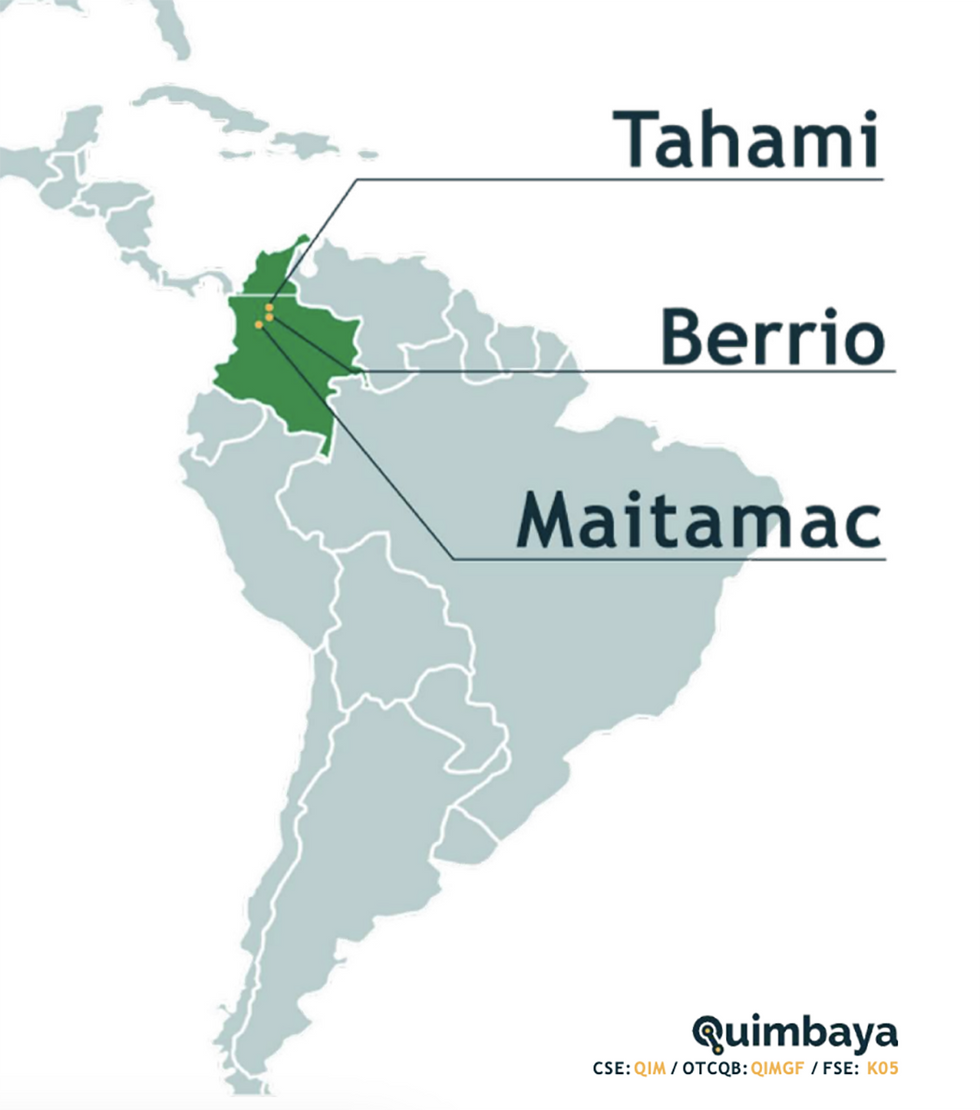
Quimbaya has established a significant partnership with Independence Drilling, Colombia’s largest drilling company with over 40 years of experience. The agreement secures 100,000 meters of drilling over five years, with Independence Drilling accepting part of its payment in Quimbaya shares. This innovative structure demonstrates strong confidence in Quimbaya’s projects, ensuring cost-effective and efficient drilling operations.
The company’s management team brings extensive and deep expertise in exploration in Colombia, corporate finance and project development. Quimbaya trades on multiple exchanges: CSE (QIM), OTCQB (QIMGF), and FSE (K05).
Company Highlights
- Quimbaya Gold controls 59,057 hectares across three distinct projects in Antioquia, Colombia — renowned as the country's top mining department, accounting for over half of Colombia’s gold production.
- The flagship Tahami project is adjacent and on trend to Aris Mining’s Segovia mine, one of the highest-grade gold mines globally. Tahami benefits from its strategic proximity to Segovia and its potential for discovery of high-grade vein gold systems.
- Tight share structure (60 percent insider/family offices/institutions ownership) with a market cap of approximately C$11.45 million, ensuring alignment with shareholder interests.
- Quimbaya has entered into a partnership with Independence Drilling, Colombia’s largest drilling company, which secures an extremely cost-effective 100,000 meters of drilling over five years.
- Quimbaya utilizes software that allows for rapid and cost-effective acquisition of mining claims, giving the company a competitive edge in securing high-value assets.
- The technical team’s proven track record of major discoveries in Colombia positions Quimbaya as a standout explorer in the region.
- Fully funded into 2026 for multi-project advancement in Colombia after closing $4 million financing
Key Projects
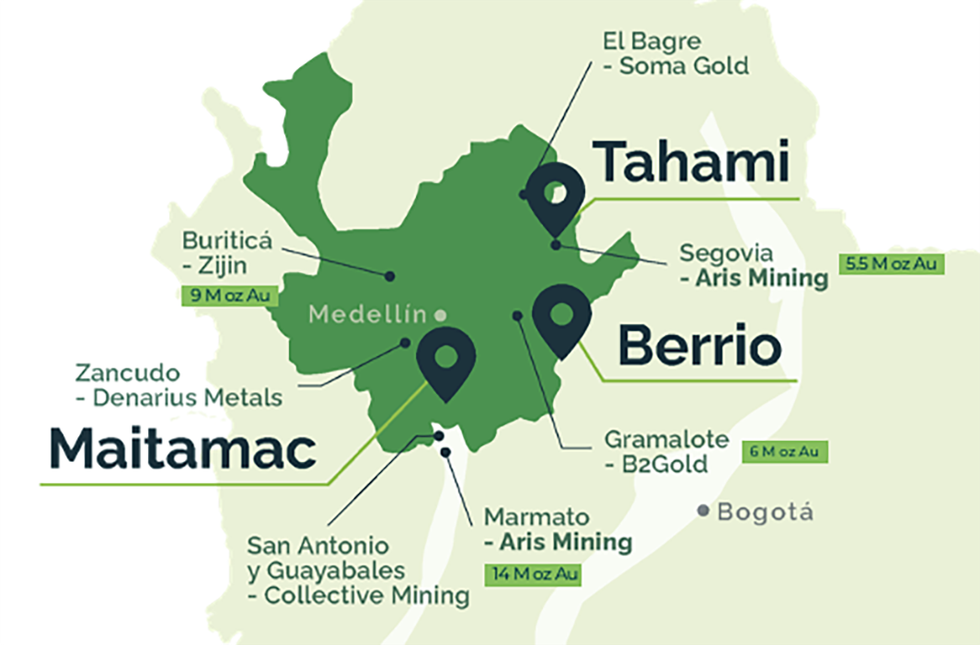
Tahami Project (Flagship)
The Tahami project is located in Segovia, Antioquia, adjacent to Aris Mining’s Segovia mine, one of the highest-grade gold mines in the world. Spanning 17,087 hectares, Tahami’s geology features mesothermal veins with multiple mineralization events underlain by Precambrian metamorphic rocks consolidated within the San Lucas Gneiss unit.
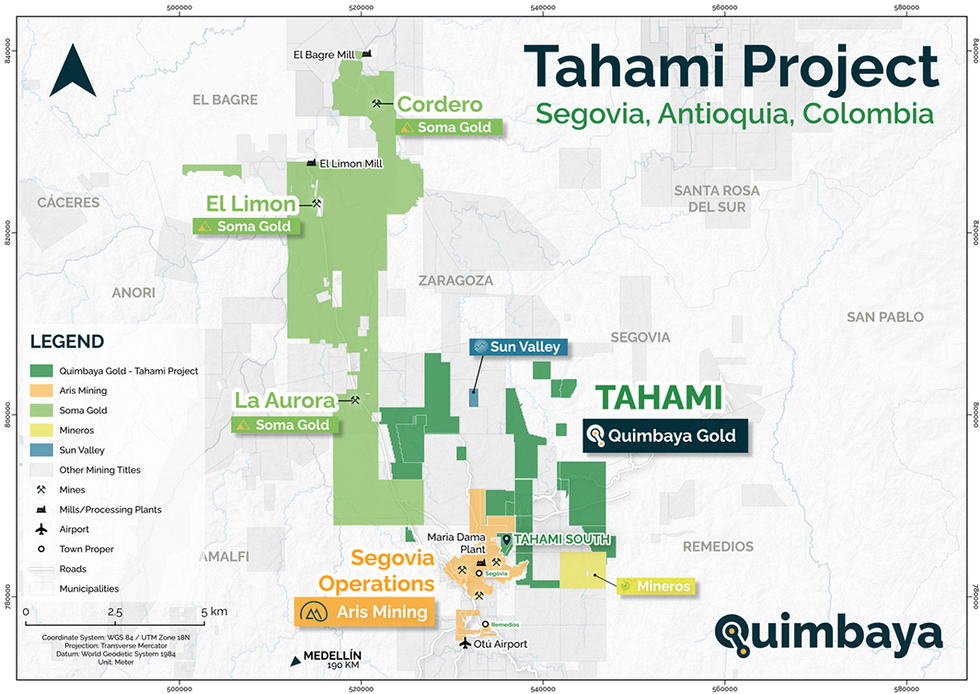
Several vein systems from Aris Mining’s Segovia project, including the Sandra K and El Silencio veins, extend towards Quimbaya’s tenements. Both the Sandra K and El Silencio veins align with structural orientations of known high-grade deposits. The project also boasts more than 25 historical artisanal mines, underscoring its prospectively.
Quimbaya’s exploration plan for Tahami involves leveraging advanced geochemical and geophysical surveys to generate drill targets. These efforts will be complemented by modern 3D geological modelling and an initial drilling campaign to test high-grade zones. The integration of historical data and cutting-edge technology positions Tahami as a prime asset for discovery. The initial drilling campaign is anticipated to commence by late Q2 of 2025 and will prioritize the high-grade targets identified in preliminary exploration work.
Maitamac Project
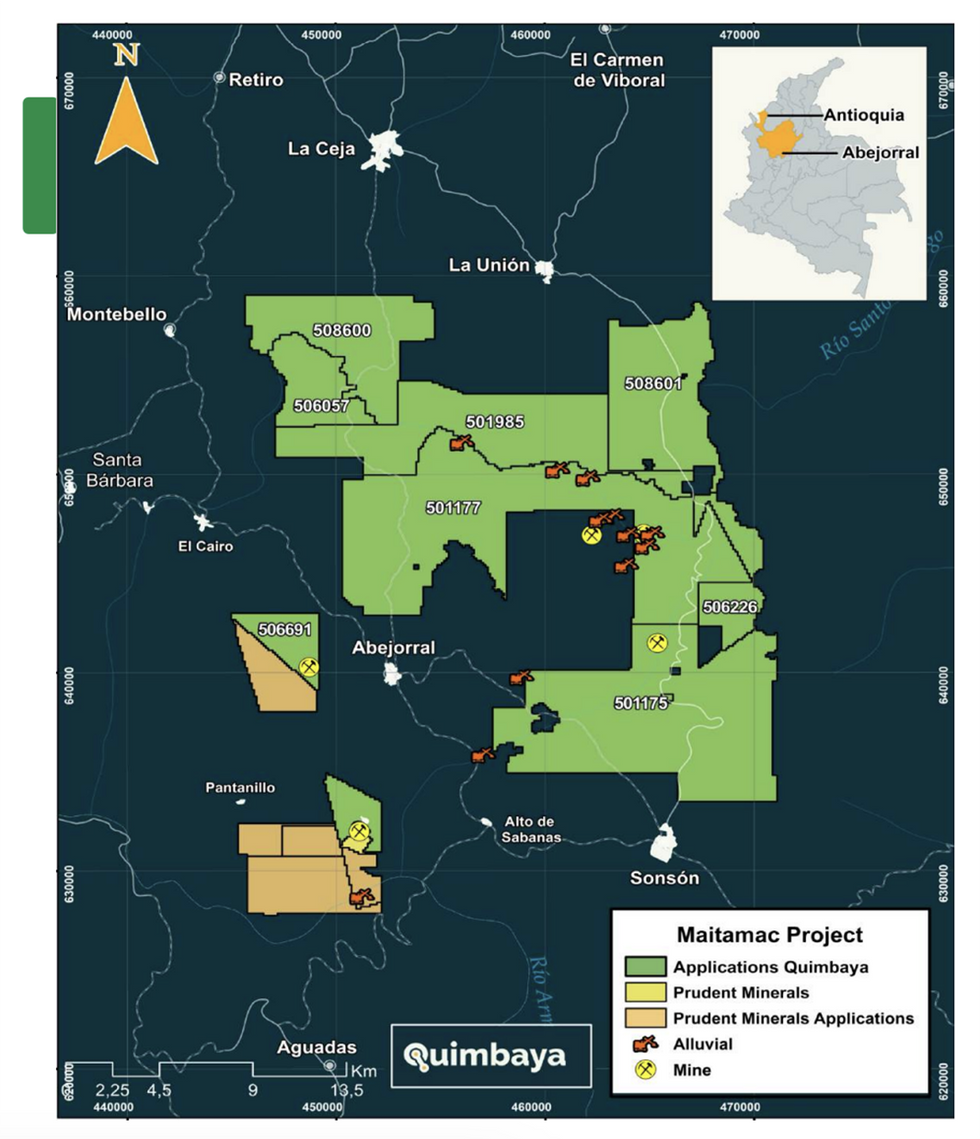
Located in Abejorral, Antioquia, 80 kilometers south of Medellín, the Maitamac project spans 33,223 hectares and offers excellent road access. This emerging gold metallogenic district features mesothermal veins and potential porphyry gold-copper systems.
Initial surface rock samples have reported gold grades of up to 3.2 g/t, with stream sediments revealing over 1 g/t gold. Identified as a promising district by the Colombian Geological Services, Maitamac is positioned alongside the past producing ABE project and structural corridor which has produced mined shoots averaging 26 g/t gold.
Team
Alexandre P. Boivin - CEO and Director
Alexandre Boivin is an entrepreneur with more than 10 years of experience in corporate finance and Colombian mining. Through his extensive experience in the mining industry, corporate finance, capital markets and business development, Boivin has been instrumental in managing and funding early-stage companies through a network of partners and investors immersed in the capital markets. Under his leadership, Quimbaya Gold has secured significant investments to advance its exploration projects. His commitment to the company's growth is further demonstrated by his substantial shareholding in Quimbaya Gold.
Olivier Berthiaume - CFO and Director
Olivier Berthiaume is an accountant with over 12 years of experience working with early-stage companies in the Canadian markets. He holds a Bachelor of Business Administration from HEC Montreal and specializes in private-to-public market transactions, compliance, corporate governance, and corporate growth strategies. Berthiaume has held various director and officer positions in junior mining companies.
Sebastian Wahl - Vice-president, Business Development
Sebastian Wahl brings over 15 years of experience in the mining industry, with a strong focus on precious metals trading, capital markets, and corporate development. Wahl has played a pivotal role in shaping Quimbaya Gold’s strategic direction and elevating its external positioning during a critical growth phase.
Ricardo Sierra – Exploration Manager
Ricardo Sierra is a professional economic Geologist with over 18 years of exploration experience in Colombia-Chile-Cuba-Brazil in orogenic, mesothermal, porphyry type deposits, epithermal systems, and stratabound. Sierra started his career with ANGLO AMERICAN as an exploration geologist in greenfield and brownfield exploration, supervising diamond drilling on their Colombian properties. His knowledge in vein systems, critical in understanding mineralization processes, was honed while exploration superintendent with Continental Gold (now Zijin Mining Group) on their Buritica (Antioquia) deposit, also in their regional exploration (Choco, Nariño, Cauca, Antioquia). Sierra graduated in 2007 as a geologist from Universidad de Caldas (Colombia). He is a member of the Australian Institute of Mining and Metallurgy (MAusIMM) and is a qualified person (QP) as defined by National Instrument 43-101, also he is a Competent Person (CP) of Comision Colombiana de Recursos y Reservas Mineras (CCRR).
Dr. Stewart Redwood - Senior Technical Advisor
Stewart Redwood is a distinguished geological consultant with more than 40 years of experience in mineral exploration and economic geology, specializing in epithermal, porphyry and skarn deposits, particularly in Latin America and the Caribbean. His notable achievements include significant discoveries, including the San Cristobal silver-zinc deposit in Bolivia, the Romero gold-copper deposit in the Dominican Republic, and the Antamina copper-zinc project in Peru, recognized as the world's largest copper skarn deposit. Throughout his career, Redwood has held key positions in prominent mining and exploration companies, including as chief geologist Latin America for AngloGold Ashanti, founder president and CEO of GoldQuest Mining, and VP exploration of Colombia Goldfields (which merged with Gran Colombia Gold). He has been instrumental in the success of Gran Colombia Gold’s Marmato project (now owned by Aris Mining), currently an 8.8 Moz deposit in the construction stage.
Nicolas Lopez Villegas - Technical Advisor
A Colombian native, with over 28 years of experience focused in the mining district of Antioquia, currently the CEO of MINING BRAIN SAS, Nicolas Lopez, leads this consulting company advising on the implementation, development of sustainable mining projects all over Colombia. Prior to the establishment of his consultancy practice, Lopez spent 12 years as Colombia & Nicaragua's country manager for IAMGOLD, having devoted the previous 10 years with MINEROS SA as head of exploration & geology. Villegas played a pivotal role in major discoveries, including the first porphyry copper-gold deposit in the Colombian middle Cauca belt, known as Titiribi. a significantly rich gold-copper geological region. As a seasoned executive in gold exploration, Villegas holds a geology degree from Universidad de Caldas (Colombia), a Governance in Oil & Mining degree from Oxford University (UK) and he is a Qualified Person (QP).
Terence Ortslan - Advisor
Terence Ortslan is a seasoned resource executive with over 40 years of experience, having served in advisory capacities across the mining, metals, and fertilizer sectors. He provides guidance on investment and technical aspects of the industry, as well as strategic and policy advice tailored to mining companies. Additionally, Ortslan advises financial institutions on investment decisions, offers direction to international industry organizations, and consults with governments on fiscal and industrial regulations. He also supports universities in enhancing their educational standards and assists corporations with decision-making, boardroom leadership, shareholder value enhancement, and strengthening ES parameters. Ortslan holds a Bachelor of Engineering & Applied Geophysics and an MBA from McGill University.
Keep reading...Show less
08 July
Asara Resources: Advancing the Next West African Gold Camp
Asara Resources (ASX:AS1,FSE:ALM) is leading the next West African gold rush from a strategic position in Guinea’s underexplored Siguiri Basin—an emerging gold district with over 30 million ounces of historical and current gold production.
Asara Resources’ flagship Kada Kold project hosts a 923,000-ounce, oxide-dominant gold resource just 35 km south of AngloGold Ashanti’s 6.2 Moz Siguiri mine. The company is systematically advancing development using the proven “string-of-pits” model that has driven success across West Africa, guided by a seasoned team behind the Kiniero Project, now a cornerstone asset for Robex (TSX:RBX).
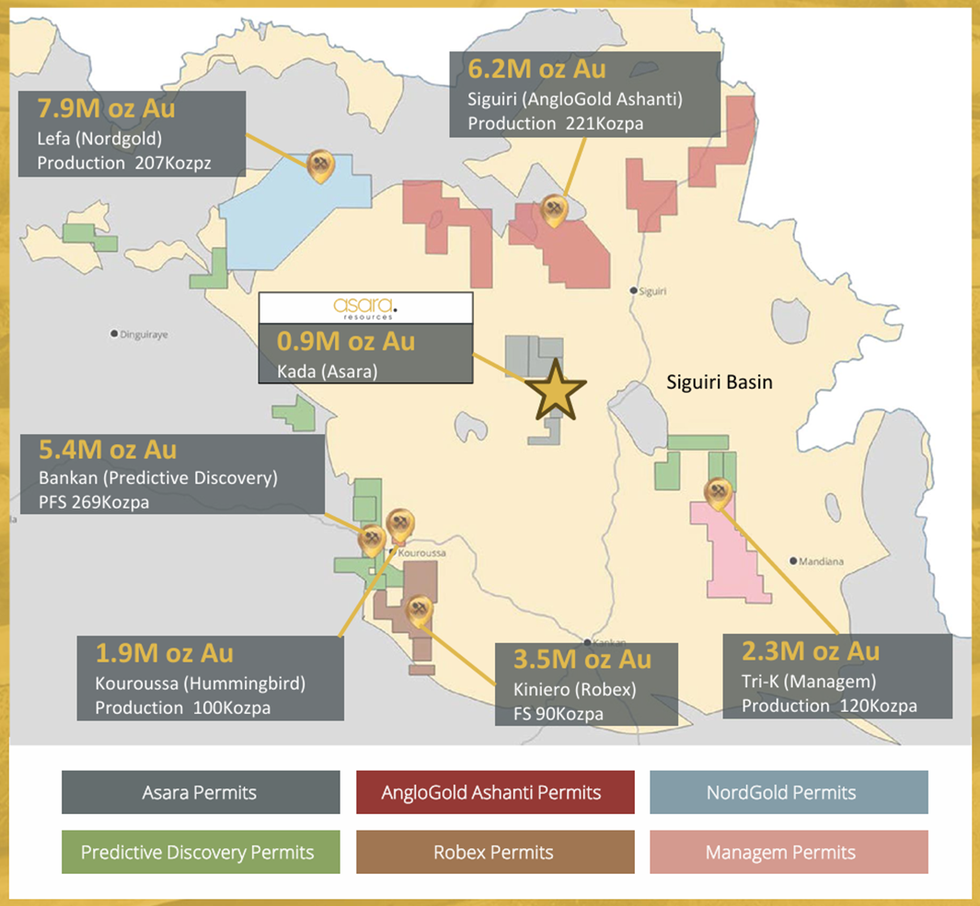
Asara’s near-term strategy focuses on three key priorities: accelerating resource growth with 33,600 metres of RC and diamond drilling planned for 2025; advancing a low-CAPEX, oxide-first development approach that capitalizes on free-dig saprolite, strong gold recoveries, and a conventional CIL flowsheet; and preserving upside exposure to copper and silver-zinc through its Loreto joint venture with Teck and the optional Paguanta asset in Chile.
Company Highlights
- Flagship Kada gold project – 923,000 oz gold and counting: 30.3 Mt @ 0.95 g/t gold with 59 percent oxide-transition ounces that show over 90 percent CIL recoveries and <3.5:1 strip ratio; resource remains open in every direction along a 15 km corridor.
- Aggressive growth runway: Three contiguous licence applications (Talico, Banan and Syli) would lift the land package to 348 sq km and extend strike control to 35 km, only ~6 percent of which is drilled.
- Experienced team who took the Kiniero project from an exploration resource to construction: Senior executives previously turned Robex’s Kiniero from 1 Moz to ~3.5 Moz and into a C$750 million market cap company, bringing an identical on-ground team, in-country relationships and proven workflows to Asara.
- Strategic Land Package: Kada is in the heart of the prolific Siguiri Basin (>30 Moz gold endowment), just 35 km south of AngloGold Ashanti’s Siguiri Mine.
- Strong Institutional Support: Top 20 shareholders control 70+ percent of the company.
This Asara Resources profile is part of a paid investor education campaign.*
Click here to connect with Asara Resources (ASX:AS1) to receive an Investor Presentation
Keep reading...Show less
08 July
New Age Exploration: High Potential for Large-scale Discovery in Western Australia and New Zealand
New Age Exploration (ASX:NAE) is shaping a focused gold exploration story anchored by high-quality assets in tier-one jurisdictions across Western Australia and New Zealand. The company’s strategy is clear: target proven geological corridors and apply modern, cost-efficient exploration methods to uncover new zones of mineralization.
In Western Australia, New Age Exploration’s Wagyu Gold Project sits directly along strike from De Grey Mining’s Hemi discovery, now part of Northern Star Resources (ASX:NST). In New Zealand, its Lammerlaw and Otago Pioneer Quartz projects are positioned within the same regional structure that hosts OceanaGold’s (TSE:OGC) 5 Moz Macraes deposit and Santana Minerals’ (ASX:SMI) fast-growing Rise & Shine system.
 Wagyu gold project location map
Wagyu gold project location mapThe Wagyu Gold Project is New Age Exploration’s flagship asset, located in the highly prospective Central Pilbara region of Western Australia. Positioned between Northern Star’s 11.7 Moz Hemi deposit and the Withnell deposit within the Mallina Basin, Wagyu targets the same intrusive-style orogenic gold system. NAE holds a 136 sq km exploration licence (E47/2974) and has completed extensive early-stage work, including reinterpretation of geophysical data to identify Hemi-style intrusions and structurally hosted gold targets.
Company Highlights
- Pilbara and Otago Exposure: Strategic landholdings in two world-class gold regions – Pilbara (WA) and Otago (NZ) – offering dual discovery potential.
- Hemi-style Intrusion Targets: The Wagyu Gold Project shares geological features and proximity with De Grey Mining’s 11.7 Moz Hemi discovery, increasing the likelihood of a major find.
- High-grade Intercepts: Recent drilling at Wagyu returned standout intercepts including 11.2 g/t gold and 1m @ 15.6 g/t gold.
- Emerging New Zealand Gold Revival: Positioned at the forefront of a regional exploration resurgence in New Zealand’s South Island, supported by rising gold prices and favorable regulatory conditions.
- Strong Cash Position: Recently raised AU$1.96 million to fund ongoing drilling, with multiple near-term catalysts expected.
This New Age Exploration profile is part of a paid investor education campaign.*
Click here to connect with New Age Exploration (ASX:NAE) to receive an Investor Presentation
Keep reading...Show less
Latest News

Sign up to get your FREE
Brightstar Resources Investor Kit
and hear about exciting investment opportunities.
- Corporate info
- Insights
- Growth strategies
- Upcoming projects
GET YOUR FREE INVESTOR KIT
Latest Press Releases
Related News
TOP STOCKS
American Battery4.030.24
Aion Therapeutic0.10-0.01
Cybin Corp2.140.00

